 Weird Stuff
Weird Stuff  Weird Stuff
Weird Stuff  Movies and TV
Movies and TV 10 Actors Who Almost Didn’t Take Career-Defining Roles
 Technology
Technology 10 Little-Known Shifts in Computer Science
 Religion
Religion 10 Catholic Histories That Reveal Acceptance of Abortion and Contraception
 Politics
Politics 10 Lesser-Known “First and Only” Facts about U.S. Presidents
 Miscellaneous
Miscellaneous 10 Things You May Not Know about the Fourth of July
 History
History 10 Shocking and Gruesome Founding Father Facts They Don’t Teach in School
 Crime
Crime The Ten Most Vicious Los Angeles Killers
 Miscellaneous
Miscellaneous 10 Indispensable Corporations the World Cannot Afford to Lose
 Animals
Animals 10 Unusual Wolves That Made The News
 Weird Stuff
Weird Stuff Ten Unexpected Discoveries Involving Vomit
 Movies and TV
Movies and TV 10 Actors Who Almost Didn’t Take Career-Defining Roles
 Technology
Technology 10 Little-Known Shifts in Computer Science
Who's Behind Listverse?

Jamie Frater
Head Editor
Jamie founded Listverse due to an insatiable desire to share fascinating, obscure, and bizarre facts. He has been a guest speaker on numerous national radio and television stations and is a five time published author.
More About Us Religion
Religion 10 Catholic Histories That Reveal Acceptance of Abortion and Contraception
 Politics
Politics 10 Lesser-Known “First and Only” Facts about U.S. Presidents
 Miscellaneous
Miscellaneous 10 Things You May Not Know about the Fourth of July
 History
History 10 Shocking and Gruesome Founding Father Facts They Don’t Teach in School
 Crime
Crime The Ten Most Vicious Los Angeles Killers
 Miscellaneous
Miscellaneous 10 Indispensable Corporations the World Cannot Afford to Lose
 Animals
Animals 10 Unusual Wolves That Made The News
Top 10 Bizarre Festivals in India
India is a land of mysticism and spirituality with several local traditions culminating in exchanges of religious ideas. Deities, which emerged with only regional cult traditions eons back, have grown to be worshiped widely today.
Consequently, by absorbing various rituals and practices, devotees came up with creative and somewhat bizarre ideas to express devotion toward their chosen deity. Listed below are the most eccentric festivals celebrated with extravagant pomp in India.
While some might make us flinch, some festivals will have us wanting to pack our bags and head straight to India to witness this large variety of cultural traditions.
10 Puli Kali
Kerala
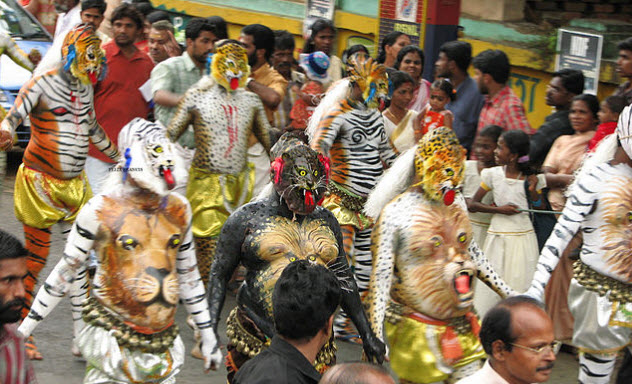
At the festival of Puli Kali in Kerala, thousands of tigers come to life, dancing and prancing around in the streets. But if you get too close, they won’t bite (hopefully) because they are simply devotees impersonating tigers.
Dressing as a tiger is a long, drawn-out process wherein the upper body of male devotees is covered in layers of paint, intricately designed as the animal down to the last whisker. The festival’s name translates into “play of the tiger,” and with men dressed as hunters, the devotee tigers play a game of hide-and-seek in which they try to avoid the hunters’ clutches.
This tradition is part of the Onam festival, which marks the harvest season. The practice of Puli Kali goes back a couple of hundred years to when a local king introduced this folk art. It was continued by soldiers who danced to music and performed steps which somewhat resembled the stance of tigers.
Well, Indians have surely lived up to their names by finding a homemade remedy for the endangerment of tigers by becoming the creatures themselves.
9 Garudan Thookkam
Kerala
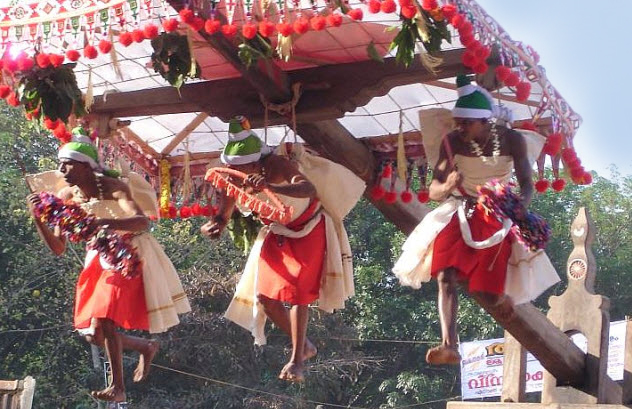
We love hanging out with our buddies. But in southern India, people love hanging down . . . from hooks. The Garudan Thookkam festival literally translates into “Eagle Hanging.”
The Garuda was a humanoid creature which was believed to be the vehicle of Lord Vishnu in Hindu mythology. Legend says that to quench the insatiable thirst of goddess Kali, Vishnu sent Garuda to her. Drinking the blood of the bleeding and dancing life-size bird pacified her.
To mark this festival today, some people in Kerala dress up as Garuda with elaborate headdresses and costumes and sing and dance. After the performance continues through the night, the Garudas hang themselves upside down from sharp hooks that pierce several parts of their bodies.
The bloody Garudas are then taken around the city temple in a procession to seek the goddess’ blessings. However, in some places today, hooks are attached not to the flesh but to a cloth tied around the waist. Looks like the people took Mariah Carey’s lyrics “fly like a bird, take to the sky” way too seriously.
8 Pushkar Fair
Rajasthan
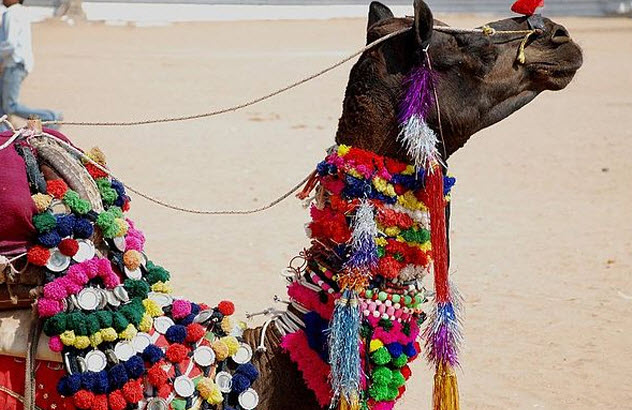
Ever dream of owning an exotic animal as a pet? Well, the natives of this desert land are living this dream and are very fond of their pet camels. The famed, annual Pushkar Fair of Rajasthan is a five-day cattle fair, the largest in Asia. It coincides with the Hindu festival of Kartik Poornima, which makes it more attractive for tourists.
The fair has found a mention here due to the quirky activities listed on the program for this festival. Camel races are something we don’t see daily, but the natives are more than familiar with this activity. These humped models also sit patiently, getting dressed and decked out with jewelry and ornaments, as they wait to be entered into beauty contests.
I challenge you to visualize the next sentence without falling off your seats with laughter: The camels are also subjected to a game of musical chairs! On the itinerary of the men, “Hey, let’s measure whose mustache is the longest” and turban-tying competitions are planned.
7 Theyyam
Kerala
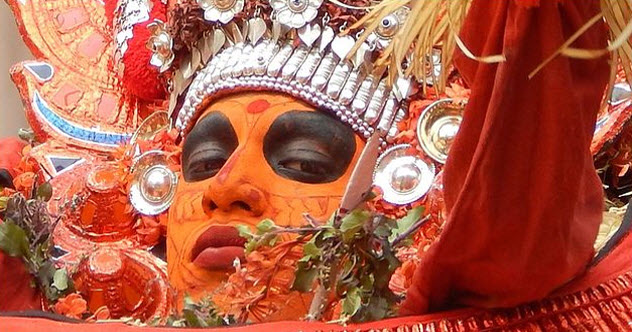
Move over salsa, ballet, jazz, and hip-hop. The “Dance of Gods” is here. The dance performed at the Theyyam festival is not simply a dance honoring the gods. Instead, the dancers are said to be possessed by the spirits of gods and mystical figures during the performance.
The gods descend to Earth through the medium of the devotees who perform and come into contact with common folk. During the dance, the dancers seem to go into a trance as they take on the life of the Theyyam, a general term for any immortal or mythological being.
Another striking feature of this celebration is the intricate makeup and headdresses donned by the dancers. The bodies of the dancers are offered as clean slates to artists who take hours splashing multiple colors on them.
Headwear is the heaviest, with some performers wearing bamboo crowns shooting up to 15–18 meters (50–60 ft). We would be concerned about the headaches which would follow, but then again, gods probably don’t suffer from the trivial ailments of mere mortals like us.
6 Lath Mar Holi
Barsana
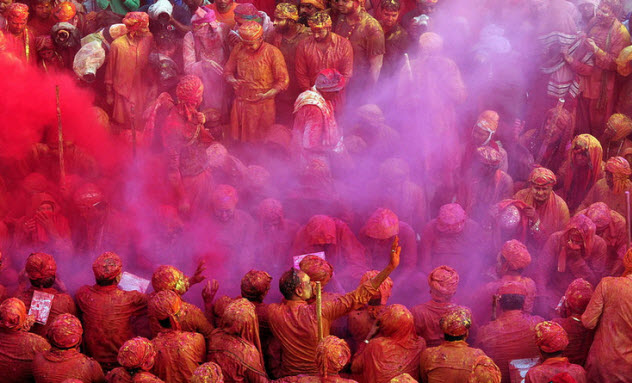
This one is all in a playful sense and has no harsh rituals. Promise! It is a local celebration of Holi, the Hindu festival of colors. Take truckloads of colors and mix them with heaps of laughter, songs, and a bucketful of traditionality. What do we get? The celebrations of Lath Mar Holi in Barsana, a small town near Mathura in the state of Uttar Pradesh.
Tradition here involves beating women and chasing men with lathis (sticks), though not with any violent intentions. According to legend, Lord Krishna, being the woman-charmer that he was, visited Barsana and playfully applied color on his beloved Radha’s face. This led to the present-day celebrations of Holi, enjoyed by the people of the town.
Unfortunate men who are unable to escape the clutches of the women are dressed in skirts and made to dance, all in a festive mood. The festival of Holi in India remains incomplete without a drink known as thandai, which is sometimes intoxicating because it is laced with cannabis. This takes the joyful spirit to new heights, literally.
5 Dhinga Gavar
Jodhpur
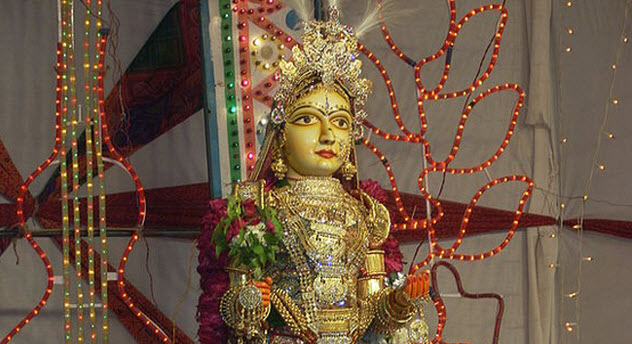
Rajasthan is a land of the unusual and might rank number one for celebrating the most extraordinary festivals. In Suncity, the festival of Dhinga Gavar witnesses the participation of large numbers of women around whom this celebration revolves.
As the legend goes, Lord Shiva (who apparently had a funny bone) once dressed up as a cobbler to tease his consort, Parvati. She reciprocated by appearing before him as a tribal woman. This led to the present tradition dedicated to Dhinga Gavar, the humorous side of Shiva’s consort.
Women of the region dress up variously as dacoits, queens, kings, police, sages, etc. It is quite a big deal because these women hire makeup artists and rent fancy costumes days in advance. They patrol the streets after sunset, and men of the city try to get in their way to get beaten up.
Ever heard of someone so eager to be beaten with sticks? The men of Jodhpur are because they believe that an unmarried man who is hit by these female impersonators will soon be hitched to the girl of his dreams. Boys, care to try this out?
4 Agni Keli
Mangalore
The bright flames of fire may be something beautiful to look at but only from a considerable distance. The people of Mangalore view the flames up close and personal during the eight-day festival at the Kateel Durga Parameshwari Temple.
On the second night, male devotees assemble at the temple and throw palm stalks at each other. As if throwing palm fronds wasn’t already risky, these fronds are lit. This practice may be the definition of fun for the people, but it is carried out to appease the goddess Durga and is a centuries-old ritual.
The devotees, wearing garments only on their lower bodies, are divided into two groups, and members of each group try to set their opponents on fire. It might be a relief (to a certain extent) to know that each person is given only five throws and this ritual lasts only 15 minutes. Phew.
3 Kaya Klesh
For almost all of us, our most prized body part, which we spend the maximum time beautifying, is our hair. Have you ever experienced that sinking feeling when one brush of your comb brings out handfuls of hair? Then this ritual carried out by Jain monks is sure to make you wince.
The Jains came up with a solution to avoid the saddening experience of hair loss. No hair equals no hair falling out. Of the 36 rules that Jain monks have to follow, one is the practice of kaya klesh or kesh lochan. From their scalps, they pluck out each strand of hair—one by one—by hand.
The ritual is carried out at least once or twice a year when the hair grows back. According to Jain tradition, the hair symbolizes illusion and attachment from which man needs to distance himself to attain liberation. This practice also teaches the monks to endure pain.
To avoid any wounds, the scalp is first dusted with dried cow dung ash before the plucking begins.
2 Banni Festival
Andhra Pradesh
Kill or be killed. That is what this festival will look like to a nonlocal onlooker. But this age-old tradition holds with it a meaning for the native peoples.
The ritual takes place with the perfect setting at midnight against the backdrop of the Devaragattu temple in the Kurnool district of Andhra Pradesh. Every year on the night of Dussehra (the 10-day Hindu festival marking the homecoming of Lord Rama), masses of devotees gather with sturdy sticks in hand.
These devotees, all men, hit each other with their sticks. The procession carries the idols of Parvati and Shiva, Hindu deities. When the ritual ends at daybreak, the sight is nothing short of a scene straight out of Kill Bill.
Though medical teams and doctors are present, they don’t do much except watch the festival. In fact, the people of Andhra are let off easy today because axes and spears were used in place of sticks as the tradition was once practiced.
1 Karni Mata Festival
Rajasthan
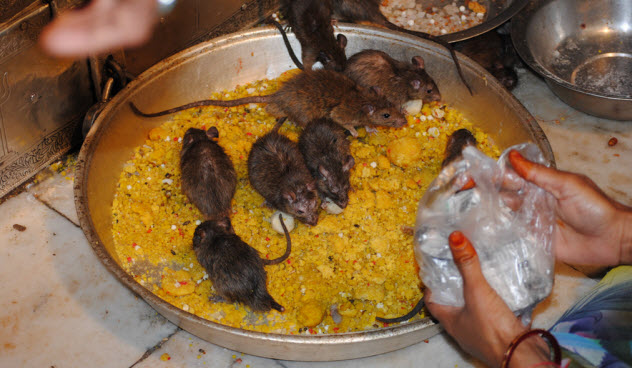
The average individual does not like rats for the simple reasons that they spread diseases, might bite, and just aren’t very attractive. But the people of Deshnoke in Rajasthan seem to turn a blind eye to it all.
The Karni Mata Temple here is also known as the Temple of Rats. This 600-year-old temple is home to approximately 20,000 rats which scurry about unafraid and deeply revered.
Numerous versions of the legend circulate. Karni Mata was a woman believed to be an incarnation of the goddess Durga. According to one version, when the son of one of her storytellers died, she requested that the god of death bring him back. When this appeal was refused, she herself reincarnated the boy (and all other storytellers, too) as rats to live in the temple and serve her forever.
Bet 100 bucks that the boy thought he was better off dead than alive as a rat. The highest honor that devotees can receive is to eat the food from which the rats have taken a bite. Also, extra blessings for the people who spot the especially holy white rats which make guest appearances from time to time.
Peek into my world on obscuretrails.wordpress.com.








